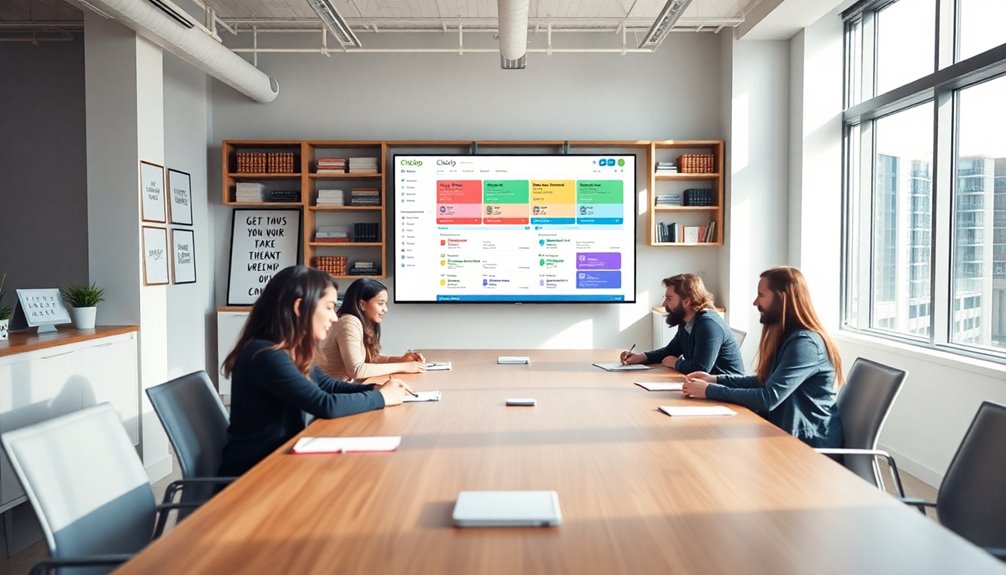When it comes to managing projects, finding the right software can make all the difference. I’ve explored various options, and there are definitely standout tools that can significantly streamline your team’s workflow. Whether you’re looking for simple task management or advanced features for complex projects, you’ll want to consider which platforms fit your needs. Let’s take a closer look at the top contenders that could transform how you organize your projects.
Key Takeaways
- Trello offers a versatile card and board system for task visualization, perfect for both personal and team projects.
- Asana’s user-friendly interface supports drag-and-drop functionality, enhancing collaboration and workflow management.
- Monday.com combines flexibility and visual clarity, providing customizable boards and automation for increased productivity.
- Wrike’s powerful features include Gantt charts for managing timelines, improving communication, and tracking multiple projects effectively.
- Microsoft Project streamlines project management with task management capabilities and seamless integration with other Microsoft applications.
Trello

When it comes to organizing tasks, Trello stands out as a versatile project management tool. I’ve found it incredibly easy to use for both personal and team projects.
The card and board system lets me visualize my tasks clearly, which keeps everything organized without overwhelming me. Each card can hold important details like deadlines, checklists, and attachments, making collaboration seamless. I can move cards through different stages of completion, giving me a sense of progress. Plus, Trello’s integration with other apps means I can customize my workflow to suit my needs.
Whether I’m planning a big project or just tracking daily tasks, Trello helps me stay focused and efficient. It’s definitely worth considering for anyone looking to streamline their productivity.
Asana

When I first started using Asana, I was impressed by its user-friendly interface.
It made organizing my tasks feel effortless, which is crucial for staying productive.
The features for task management really helped me keep track of everything I needed to do.
User-Friendly Interface
Asana stands out with its user-friendly interface, making project management feel intuitive and accessible. When I first used it, I was impressed by how easy it was to navigate. The clean design keeps everything organized without overwhelming you.
I love that I can quickly create tasks, set due dates, and assign them to team members—all with just a few clicks. The drag-and-drop functionality simplifies arranging tasks and prioritizing projects, which saves me time and effort. Plus, the visual layout allows me to see the progress at a glance, helping me stay focused.
Task Management Features
Although many project management tools offer basic task management features, Asana truly excels in this area with its robust suite of options. I love how easy it’s to create, assign, and prioritize tasks within the platform. The ability to set due dates and add subtasks helps streamline our workflow.
One feature I find particularly helpful is the task dependencies; it visually shows which tasks need completion before others can start. The calendar view keeps our deadlines manageable, while the progress tracking ensures transparency in our projects. Plus, I appreciate the ability to add notes and files directly to each task, making collaboration seamless. Asana transforms task management into a user-friendly experience that keeps everyone aligned and accountable.
Monday.com

Monday.com has quickly become a go-to project management tool for teams looking to streamline their workflows. I love how it blends flexibility with visual clarity, letting me customize my boards to suit any project’s needs.
With its user-friendly interface, I don’t waste time figuring things out; the drag-and-drop features make task management a breeze. I can easily assign tasks, set deadlines, and track progress in real-time. I also appreciate the automation capabilities, which save me time on repetitive tasks. The integrations with other tools, like Slack and Google Drive, enhance collaboration and keep everything centralized.
Ultimately, Monday.com helps me boost my team’s productivity while keeping everyone aligned and engaged. It’s truly a game-changer.
Wrike

When I first tried Wrike, I was impressed by its powerful features that cater to fast-paced teams. The interface is intuitive, allowing me to create and customize dashboards effortlessly. I loved how easy it was to assign tasks and set deadlines while keeping everyone in the loop with real-time updates.
One standout feature is Wrike’s Gantt chart, which visually helped manage project timelines and dependencies. Keeping track of multiple projects became a breeze. Additionally, the collaboration tools, like document sharing and discussions, significantly improved communication within my team. Wrike’s integrations with other apps streamlined our workflow.
ClickUp

After exploring Wrike, I was eager to try ClickUp, and it certainly didn’t disappoint.
This tool is incredibly versatile, allowing me to manage tasks, projects, and even team collaboration effortlessly.
I love how I can customize my workspace to fit my workflow, whether I prefer lists, boards, or calendars.
The ability to assign tasks, set priorities, and track progress in real-time has made a significant difference in my productivity.
Plus, ClickUp integrates seamlessly with other apps I use daily, streamlining my processes.
I particularly appreciate the goal-setting feature, which helps me keep my objectives in sight.
Basecamp

As I delved into Basecamp, I quickly realized its unique approach to project management sets it apart from other tools I’ve tried. The interface is straightforward, making it easy for everyone on the team to navigate and collaborate.
I appreciate how Basecamp organizes projects into distinct sections, allowing me to focus on what truly matters without getting lost in the details. The automatic check-ins encourage communication, ensuring team members stay updated without endless meetings. Plus, the To-Do lists help me prioritize tasks efficiently.
I also love that all discussions, files, and schedules are centralized, reducing the need for multiple apps. Overall, Basecamp’s simplicity and effective organization empower my team to collaborate seamlessly and boost our productivity.
Jira

Although I’ve tried various project management tools, Jira consistently stands out for its powerful features tailored for software development teams.
Its flexibility to adapt to various workflows has been a game-changer for my projects.
I love how I can easily set up boards, track progress, and prioritize tasks.
The integration with other tools like GitHub and Slack makes collaboration seamless, which is crucial for us.
Plus, the reporting features give me valuable insights into team performance and project timelines.
Whether I’m managing sprints or tackling bugs, Jira keeps everything organized and accessible.
Overall, if you’re looking for a robust solution to streamline your development process, you can’t go wrong with Jira.
It’s truly become an essential tool in my toolkit.
Smartsheet

While exploring various project management tools, I was pleasantly surprised by Smartsheet’s versatility and user-friendly interface. This platform combines the familiarity of spreadsheets with powerful project management features, making it a breeze to navigate.
I can easily create tasks, set deadlines, and assign responsibilities, all while keeping the big picture in mind. Smartsheet’s real-time collaboration tools allow my team to update progress and provide feedback instantly, ensuring everyone stays on the same page. With customizable templates, I can tailor workflows to meet specific project needs. Plus, the integration with other tools streamlines my processes.
Teamwork

When I think about teamwork, I immediately consider how crucial effective communication is for success.
It’s not just about sharing information; it’s also about delegating roles clearly to make sure everyone knows their responsibilities.
Let’s explore some strategies that can enhance our collaboration.
Effective Communication Strategies
Effective communication strategies are crucial for successful teamwork, as they foster collaboration and understanding among team members. I’ve found that setting clear expectations right from the start can eliminate confusion. Regular check-ins keep everyone aligned and provide a space for feedback.
Utilizing tools like instant messaging or project management software helps maintain open channels for questions and updates. I also encourage team members to actively listen and share their ideas—this ensures everyone feels valued. Sharing progress and challenges not only builds trust but also drives accountability.
Always remember, it’s about creating an environment where everyone can express themselves freely, leading to more effective problem-solving and innovation. Communication really is the backbone of any successful team.
Role Delegation Best Practices
Building on the foundation of clear communication, role delegation is a key element in maximizing team efficiency and productivity. I’ve found that the best practice is to align tasks with team members’ strengths and interests. It’s crucial to clearly outline expectations and deadlines, so everyone knows their responsibilities. Regular check-ins help keep everyone on track and motivated.
I also recommend empowering team members to take ownership of their tasks; this fosters accountability and innovation. Don’t hesitate to provide support when needed, but allow them the space to tackle challenges independently. Lastly, encourage open feedback to fine-tune processes—it strengthens collaboration and enhances results. By implementing these strategies, I’ve seen substantial improvements in team dynamics and project outcomes.
Microsoft Project

Microsoft Project is a powerful tool that simplifies project management for professionals and teams alike. I’ve used it to streamline my projects effectively.
This software offers robust features like Gantt charts and timeline tracking, which help me visualize workflows and deadlines clearly. The task management capabilities allow me to assign roles and monitor progress effortlessly, ensuring everyone stays accountable. Plus, Microsoft Project integrates seamlessly with other Microsoft applications, making it easier to share resources and collaborate with my team.
I appreciate how it helps me stay organized, allowing me to focus on the project’s priorities rather than getting lost in details. Overall, it’s a solid choice if you’re looking for a reliable project management solution.
Conclusion
In conclusion, choosing the right project management software can truly transform how your team collaborates and stays organized. Each tool offers unique features tailored to different workflows and styles. Whether you need the simplicity of Trello or the advanced capabilities of Wrike, there’s something for everyone. Take the time to explore these options and find the one that fits your needs best. You’ll be amazed at how much more productive your team can become!


